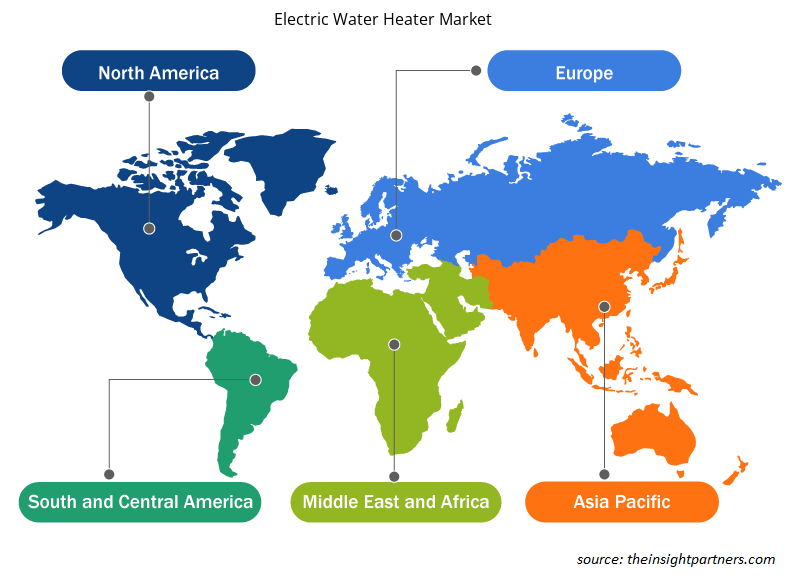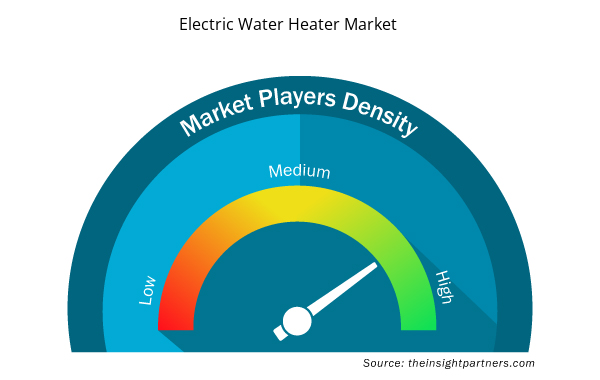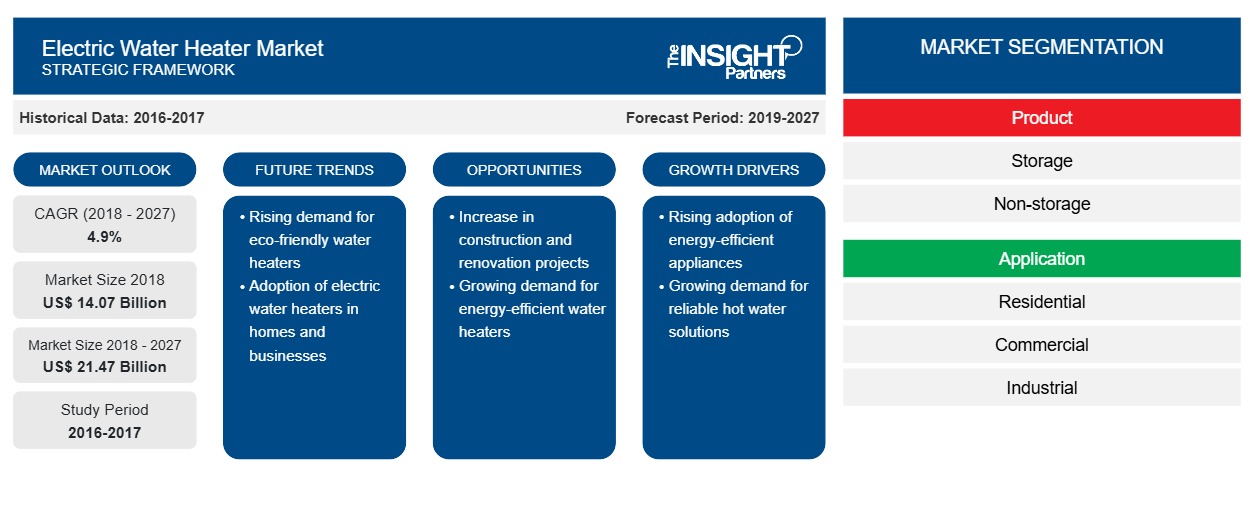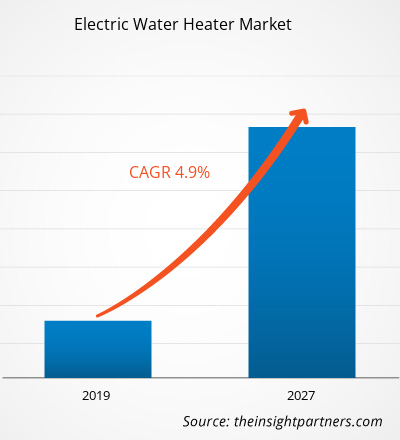Si prevede che il mercato globale degli scaldabagni elettrici crescerà da 14,07 miliardi di dollari nel 2018 a 21,47 miliardi di dollari entro il 2027. Ciò rappresenta un CAGR del 4,9% dall'anno 2019 al 2027.
L'Asia Pacifica è stato il mercato geografico leader e si prevede che sarà il maggiore contributore di fatturato per tutto il periodo di previsione. Nell'APAC, il rapido sviluppo delle infrastrutture di varie unità residenziali, commerciali e industriali sta guidando il mercato degli scaldabagni elettrici APAC e questo continuerà a guidare nei prossimi dieci anni.
Approfondimenti di mercato
Il fattore immigrazione urbana è un fattore chiave che influenza il mercato degli scaldabagni elettrici
Diversi paesi in tutto il mondo stanno vivendo un'enorme tendenza alla migrazione urbana. La migrazione urbana è una tendenza in crescita nel ventunesimo secolo. I parametri chiave che guidano la tendenza alla migrazione urbana includono opportunità di lavoro, opportunità educative e opportunità mediche. Inoltre, l'aumento dei livelli di reddito tra la società della classe media e migliori standard di vita sono fattori chiave che contribuiscono alla ricollocazione urbana. La crescente tendenza alla migrazione urbana ha portato allo sviluppo di infrastrutture residenziali, che è un fattore chiave che catalizza la crescita del mercato degli scaldabagni elettrici nello scenario attuale.
La popolazione urbana trae maggiori benefici rispetto alle aree rurali e cerca di migliorare lo standard di vita. Per quanto riguarda il fattore sopra menzionato, i vari sviluppatori di tecnologie, produttori di materie prime, organizzazioni di produzione di energia ed energia, sviluppatori di infrastrutture e governi si sforzano costantemente di soddisfare le esigenze della popolazione urbana. La migrazione urbana e gli standard di vita più elevati, insieme alle tecnologie in crescita e alle politiche governative, guidano la crescita delle infrastrutture residenziali in vari paesi in via di sviluppo e nelle nazioni sviluppate. Il crescente numero di infrastrutture residenziali sta facilitando gli operatori del mercato degli scaldabagni elettrici a testimoniare la crescita della domanda per i rispettivi prodotti.
Personalizza questo report in base alle tue esigenze
Riceverai la personalizzazione gratuita di qualsiasi report, comprese parti di questo report, o analisi a livello nazionale, pacchetto dati Excel, oltre a usufruire di grandi offerte e sconti per start-up e università
- Scopri le principali tendenze di mercato in questo rapporto.Questo campione GRATUITO includerà analisi di dati che spaziano dalle tendenze di mercato alle stime e alle previsioni.
L'infrastruttura residenziale in crescita in tutto il mondo sta consentendo agli operatori di mercato che operano nel mercato degli scaldabagni elettrici di migliorare la rispettiva gamma di prodotti per attrarre un'ampia varietà di clienti. La consapevolezza dei vantaggi e delle aree di applicazione degli scaldabagni elettrici sta raggiungendo il picco tra la popolazione urbana e, a tal proposito, l'adozione degli stessi è in continua crescita, il che sta quindi fornendo le dimensioni del fatturato del mercato degli scaldabagni elettrici. Pertanto, con la crescente migrazione dalle aree rurali alle aree urbane in diversi paesi, la domanda di scaldabagni elettrici nel settore residenziale salirà alle stelle nei prossimi anni. Pertanto, il fattore di immigrazione urbana è un fattore chiave influente per il mercato degli scaldabagni elettrici durante tutto il periodo di previsione.
Approfondimenti sui prodotti
Il sottoprodotto del mercato globale degli scaldabagni elettrici è stato guidato dal segmento di accumulo. Il segmento non di accumulo ha detenuto il secondo mercato più grande nel 2018 e si prevede che aumenterà le sue quote durante il periodo di previsione dal 2019 al 2027.
Approfondimenti sulle applicazioni
Il mercato globale degli scaldabagni elettrici per applicazione è stato guidato dal segmento residenziale. Il segmento commerciale ha detenuto il secondo mercato più grande nel 2018 e si prevede che aumenterà le sue quote durante il periodo di previsione dal 2019 al 2027.
Gli attori del mercato presenti nel mercato degli scaldabagni elettrici si stanno concentrando principalmente sui miglioramenti dei prodotti implementando tecnologie avanzate. Di seguito sono elencati alcuni degli sviluppi recenti:
2019: PHCC ha ampliato lo stato di partnership di Bradford White Corp. alla categoria Strategic Partner. Il riconoscimento amplia la partnership da Bradford White Water Heaters all'intera Bradford White Corp.
2019: Bradford White ha annunciato il lancio della sua nuova risorsa web per appaltatori, For The Pro, pensata su misura per installatori professionisti di soluzioni Bradford White per il riscaldamento dell'acqua, il riscaldamento degli ambienti, il riscaldamento combinato e l'accumulo per applicazioni residenziali, commerciali e industriali.
2018: AO Smith ha aperto il nuovo Lloyd R. Smith Corporate Technology Center che fungerà da hub di innovazione globale per i prodotti AO Smith in tutto il mondo.
Approfondimenti regionali sul mercato degli scaldabagni elettrici
Le tendenze regionali e i fattori che influenzano il mercato degli scaldabagni elettrici durante il periodo di previsione sono stati ampiamente spiegati dagli analisti di Insight Partners. Questa sezione discute anche i segmenti e la geografia del mercato degli scaldabagni elettrici in Nord America, Europa, Asia Pacifico, Medio Oriente e Africa e Sud e Centro America.

- Ottieni i dati specifici regionali per il mercato degli scaldabagni elettrici
Ambito del rapporto di mercato dello scaldabagno elettrico
| Attributo del report | Dettagli |
|---|---|
| Dimensioni del mercato nel 2018 | 14,07 miliardi di dollari USA |
| Dimensioni del mercato entro il 2027 | 21,47 miliardi di dollari USA |
| CAGR globale (2018 - 2027) | 4,9% |
| Dati storici | 2016-2017 |
| Periodo di previsione | 2019-2027 |
| Segmenti coperti | Per Prodotto
|
| Regioni e Paesi coperti | America del Nord
|
| Leader di mercato e profili aziendali chiave |
|
Densità dei player del mercato degli scaldabagni elettrici: comprendere il suo impatto sulle dinamiche aziendali
Il mercato degli scaldabagni elettrici sta crescendo rapidamente, spinto dalla crescente domanda degli utenti finali dovuta a fattori quali l'evoluzione delle preferenze dei consumatori, i progressi tecnologici e una maggiore consapevolezza dei vantaggi del prodotto. Con l'aumento della domanda, le aziende stanno ampliando le loro offerte, innovando per soddisfare le esigenze dei consumatori e capitalizzando sulle tendenze emergenti, il che alimenta ulteriormente la crescita del mercato.
La densità degli operatori di mercato si riferisce alla distribuzione di aziende o società che operano in un particolare mercato o settore. Indica quanti concorrenti (operatori di mercato) sono presenti in un dato spazio di mercato in relazione alle sue dimensioni o al valore di mercato totale.
Le principali aziende che operano nel mercato degli scaldabagni elettrici sono:
- Società AO Smith
- Ariston Thermo SpA
- Società elettrica Bajaj Ltd.
- Società per azioni Bradford White Corp.
- La società Whirlpool
Disclaimer : le aziende elencate sopra non sono classificate secondo un ordine particolare.

- Ottieni una panoramica dei principali attori del mercato degli scaldabagni elettrici
MERCATO GLOBALE DEGLI SCALDABAGNO ELETTRICI – SEGMENTAZIONE DEL MERCATO
Mercato globale degli scaldabagni elettrici per prodotto
- Magazzinaggio
- < 30 litri
- 30 - 100 litri
- 100 - 250 litri
- 250 - 400 litri
- > 400 litri
- Non immagazzinamento
Mercato globale degli scaldabagni elettrici per applicazione
- Residenziale
- Commerciale
- Industriale
Mercato globale degli scaldabagni elettrici per regione
- America del Nord
- Europa
- Asia Pacifico
- Medio Oriente e Africa
- Sud America
Aziende menzionate
- Società AO Smith
- Ariston Thermo Group SpA
- Società elettrica Bajaj Ltd.
- Gruppo Bosch
- Società per azioni Bradford White (BWC)
- Haier Smart Home Co., Ltd.
- Midea Group Co., Ltd.
- Siemens AG
- Viessmann Werke GmbH & Co. KG
- La società Whirlpool
- Analisi storica (2 anni), anno base, previsione (7 anni) con CAGR
- Analisi PEST e SWOT
- Valore/volume delle dimensioni del mercato - Globale, regionale, nazionale
- Industria e panorama competitivo
- Set di dati Excel



Report Coverage
Revenue forecast, Company Analysis, Industry landscape, Growth factors, and Trends

Segment Covered
This text is related
to segments covered.

Regional Scope
North America, Europe, Asia Pacific, Middle East & Africa, South & Central America

Country Scope
This text is related
to country scope.
Domande frequenti
The demand for electric water heaters is expected to increase in the developing areas as the number of houses, hotels, commerce zones, shopping malls, hospitals, and industrial buildings in the developing countries is increasing, which is demanding electric water heaters. This is due to the fact that the count of each of the commercial spaces mentioned overhead is continuously growing, which is leading to the higher procurement rate of electric water heaters. Additionally, electricity in the developing countries are comparatively cheaper than the developed countries, the cost associated with gas filling in gas water heaters is omitted, and faster heating time on electric water heaters have attracted a significant percentage of urban population residing in the countries mentioned above. This parameter is foreseen to furnish the electric water heater market in the coming years.
In the region, swift development of infrastructure of various residential, commercial, and industrial units is driving the APAC electric water heater market, and this would continue to drive in the coming ten years. The building construction investment by respective state government authorities would positively optimize the business outlook; the rising demand for electric water heaters, both storage as well as non-storage, would also augment the industry landscape.
Increasing construction activities and increase of the building infrastructure is driving the electric storage water heating demand across commercial establishments. Stringent government orders aiming to decrease the carbon footprint along with rising urbanization & commercialization would accelerate the demand for storage water heaters. Electric storage water heaters are used in various industrial applications for efficient heating. When it comes to efficiency and economy, electric storage water heaters are the best option in their category.
Trends and growth analysis reports related to Electronics and Semiconductor : READ MORE..
The List of Companies
- AO Smith Corporation
- Ariston Thermo S.p.A
- Bajaj Electricals Ltd.
- Bradford White Corp.
- Whirlpool Corporation
- Haier Inc.
- Midea Group
- Bosch Thermotechnology
- Siemens AG
- Viesmann Group
The Insight Partners performs research in 4 major stages: Data Collection & Secondary Research, Primary Research, Data Analysis and Data Triangulation & Final Review.
- Data Collection and Secondary Research:
As a market research and consulting firm operating from a decade, we have published and advised several client across the globe. First step for any study will start with an assessment of currently available data and insights from existing reports. Further, historical and current market information is collected from Investor Presentations, Annual Reports, SEC Filings, etc., and other information related to company’s performance and market positioning are gathered from Paid Databases (Factiva, Hoovers, and Reuters) and various other publications available in public domain.
Several associations trade associates, technical forums, institutes, societies and organization are accessed to gain technical as well as market related insights through their publications such as research papers, blogs and press releases related to the studies are referred to get cues about the market. Further, white papers, journals, magazines, and other news articles published in last 3 years are scrutinized and analyzed to understand the current market trends.
- Primary Research:
The primarily interview analysis comprise of data obtained from industry participants interview and answers to survey questions gathered by in-house primary team.
For primary research, interviews are conducted with industry experts/CEOs/Marketing Managers/VPs/Subject Matter Experts from both demand and supply side to get a 360-degree view of the market. The primary team conducts several interviews based on the complexity of the markets to understand the various market trends and dynamics which makes research more credible and precise.
A typical research interview fulfils the following functions:
- Provides first-hand information on the market size, market trends, growth trends, competitive landscape, and outlook
- Validates and strengthens in-house secondary research findings
- Develops the analysis team’s expertise and market understanding
Primary research involves email interactions and telephone interviews for each market, category, segment, and sub-segment across geographies. The participants who typically take part in such a process include, but are not limited to:
- Industry participants: VPs, business development managers, market intelligence managers and national sales managers
- Outside experts: Valuation experts, research analysts and key opinion leaders specializing in the electronics and semiconductor industry.
Below is the breakup of our primary respondents by company, designation, and region:

Once we receive the confirmation from primary research sources or primary respondents, we finalize the base year market estimation and forecast the data as per the macroeconomic and microeconomic factors assessed during data collection.
- Data Analysis:
Once data is validated through both secondary as well as primary respondents, we finalize the market estimations by hypothesis formulation and factor analysis at regional and country level.
- Macro-Economic Factor Analysis:
We analyse macroeconomic indicators such the gross domestic product (GDP), increase in the demand for goods and services across industries, technological advancement, regional economic growth, governmental policies, the influence of COVID-19, PEST analysis, and other aspects. This analysis aids in setting benchmarks for various nations/regions and approximating market splits. Additionally, the general trend of the aforementioned components aid in determining the market's development possibilities.
- Country Level Data:
Various factors that are especially aligned to the country are taken into account to determine the market size for a certain area and country, including the presence of vendors, such as headquarters and offices, the country's GDP, demand patterns, and industry growth. To comprehend the market dynamics for the nation, a number of growth variables, inhibitors, application areas, and current market trends are researched. The aforementioned elements aid in determining the country's overall market's growth potential.
- Company Profile:
The “Table of Contents” is formulated by listing and analyzing more than 25 - 30 companies operating in the market ecosystem across geographies. However, we profile only 10 companies as a standard practice in our syndicate reports. These 10 companies comprise leading, emerging, and regional players. Nonetheless, our analysis is not restricted to the 10 listed companies, we also analyze other companies present in the market to develop a holistic view and understand the prevailing trends. The “Company Profiles” section in the report covers key facts, business description, products & services, financial information, SWOT analysis, and key developments. The financial information presented is extracted from the annual reports and official documents of the publicly listed companies. Upon collecting the information for the sections of respective companies, we verify them via various primary sources and then compile the data in respective company profiles. The company level information helps us in deriving the base number as well as in forecasting the market size.
- Developing Base Number:
Aggregation of sales statistics (2020-2022) and macro-economic factor, and other secondary and primary research insights are utilized to arrive at base number and related market shares for 2022. The data gaps are identified in this step and relevant market data is analyzed, collected from paid primary interviews or databases. On finalizing the base year market size, forecasts are developed on the basis of macro-economic, industry and market growth factors and company level analysis.
- Data Triangulation and Final Review:
The market findings and base year market size calculations are validated from supply as well as demand side. Demand side validations are based on macro-economic factor analysis and benchmarks for respective regions and countries. In case of supply side validations, revenues of major companies are estimated (in case not available) based on industry benchmark, approximate number of employees, product portfolio, and primary interviews revenues are gathered. Further revenue from target product/service segment is assessed to avoid overshooting of market statistics. In case of heavy deviations between supply and demand side values, all thes steps are repeated to achieve synchronization.
We follow an iterative model, wherein we share our research findings with Subject Matter Experts (SME’s) and Key Opinion Leaders (KOLs) until consensus view of the market is not formulated – this model negates any drastic deviation in the opinions of experts. Only validated and universally acceptable research findings are quoted in our reports.
We have important check points that we use to validate our research findings – which we call – data triangulation, where we validate the information, we generate from secondary sources with primary interviews and then we re-validate with our internal data bases and Subject matter experts. This comprehensive model enables us to deliver high quality, reliable data in shortest possible time.


 Ottieni un campione gratuito per questo repot
Ottieni un campione gratuito per questo repot